常用八大排序算法
排序分为内部排序和外部排序。内部排序在内存中进行,外部排序使用内存和外存实现。
本文介绍的八种排序算法属于内部排序,使用java语言实现。
1.冒泡排序(BubbleSort)
1.1 排序思想:
冒泡排序,一组无序的数,对相邻的两个数依次进行比较和调整,让较大的数往下沉,较小的往上冒。
1.2 冒泡排序图示:
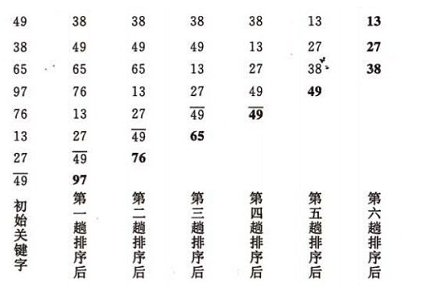
1.3 算法java代码实现:
public void bubbleSort()
{
for(int i=1;i<n;i++)
{
for(int j=0;j<n-i;j++)
{
if(a[j]>a[j+1])
{
swap(j,j+1);
}
}
}
}1.4 时间复杂度:O(n^2)
2.选择排序(SelectSort)
2.1 排序思想:
选择排序,一组无序的数,选出最小(或者最大)的一个数与第1个位置的数交换;然后在剩下的数当中再找最小(或者最大)的与第2个位置的数交换,依次类推,完成从小到大(或者从大到小)排序。
2.2 选择排序图示:
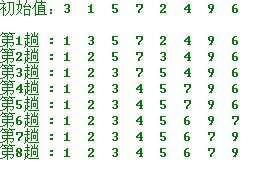
2.3 算法java代码实现:
public void selectSort()
{
for(int i=0;i<n;i++)
{
for(int j=i+1;j<n;j++)
{
if(a[i]<a[j])
{
swap(i,j);
}
}
}
}2.4 时间复杂度:O(n^2)
3.插入排序(InsertSort)
3.1 排序思想:
插入排序,将序列的第1个元素看作一个有序的子序列,然后向该子序列中逐个插入剩余的元素直到序列完全有序。
3.2 插入排序图示:
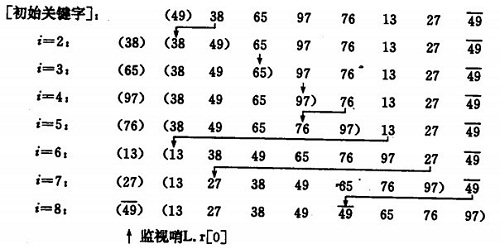
3.3 算法java代码实现:
public void insertionSort()
{
int i,j;
for(i=0;i<n;i++)
{
long temp=a[i];
j=i;
while(j>0&&a[j-1]>=temp)
{
a[j]=a[j-1];
--j;
}
a[j]=temp;
}
}3.4 时间复杂度:O(n^2)
4.归并排序(MergeSort)
4.1 排序思想:
归并排序,将一个无序序列反复平分,设定只有一个数据项的子序列是有序的(基值条件),然后在依次归并子序列,生成一个有序的原序列。
4.2 归并排序图示:

4.3 算法java代码实现:
public static void sort(int[] nums, int low, int high) {
int mid = (low + high) / 2;
if (low < high) {
// 左边
sort(nums, low, mid);
// 右边
sort(nums, mid + 1, high);
// 左右归并
merge(nums, low, mid, high);
}
}
public static void merge(int[] nums, int low, int mid, int high) {
int[] temp = new int[high - low + 1];
int i = low;// 左指针
int j = mid + 1;// 右指针
int k = 0;
// 把较小的数先移到新数组中
while (i <= mid && j <= high) {
if (nums[i] < nums[j]) {
temp[k++] = nums[i++];
} else {
temp[k++] = nums[j++];
}
}
// 把左边剩余的数移入数组
while (i <= mid) {
temp[k++] = nums[i++];
}
// 把右边边剩余的数移入数组
while (j <= high) {
temp[k++] = nums[j++];
}
// 把新数组中的数覆盖nums数组
for (int k2 = 0; k2 < temp.length; k2++) {
nums[k2 + low] = temp[k2];
}
} 4.4 时间复杂度:O(N*logN)
5.希尔排序(ShellSort)
5.1 排序思想:
希尔排序,基于插入排序,加大插入排序中元素之间的间隔,并在这些有间隔的元素之间进行插入排序,从而使数据项可以大幅度跨动,一趟排序完成后,减小间隔(间隔最小是1)再排序,依次进行下去,。
5.2 希尔排序图示:
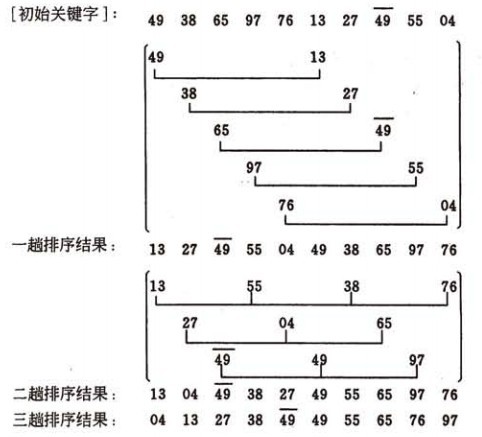
5.3 算法java代码实现:
public void shellSort(){
int h=1;
int inner,outer;
long temp;
while(h<=n/3)
h=h*3+1;
while(h>0){
for(outer=h;outer<n;outer++){
temp=theArray[outer];
inner=outer;
while(inner>h-1&&theArray[inner-h]>=temp){
theArray[inner]=theArray[inner-h];
inner=inner-h;
}
theArray[inner]=temp;
}
h=(h-1)/3;
}
}5.4 时间复杂度:没有确定的,O(N^(x/y))
6.快速排序(QuickSort)
6.1 排序思想:
快速排序,首先,选择序列中一个基准元素(三数据项取中法);然后,通过一趟排序把无序的序列分割成两部分,其中一部分序列的元素值比基准元素值小,另一部分序列的 元素值比基准值大,并且基准元素在其排好序后的正确位置;接着,再对这两部分序列用同样的方法进行排序,依次进行下去;最后,整个序列有序。
6.2 快速排序图示:
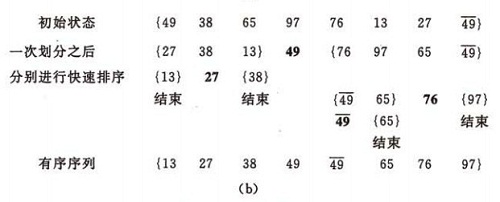
6.3 算法java代码实现:
public void quickSort(){
recQuickSort(0,n-1);
}
public void recQuickSort(int left,int right){
int size=right-left+1;
if(size<=3)
manualSort(left,right);
else {
long median=median3(left,right);
int partition=partitionIt(left,right,median);
recQuickSort(left,partition-1);
recQuickSort(partition+1,right);
}
}
public long median3(int left,int right){
int center=(left+right)/2;
if(theArray[left]>theArray[center])
swap(left,center);
if(theArray[left]>theArray[right])
swap(left,right);
if(theArray[center]>theArray[right])
swap(center,right);
swap(center,right);
return theArray[right];
}
public void swap(int dex1,int dex2){
long t=theArray[dex1];
theArray[dex1]=theArray[dex2];
theArray[dex2]=t;
}
public int partitionIt(int left,int right,long pivon){
int leftptr=left;
int rightptr=right;
while(true){
while(theArray[++leftptr]<pivon)
;
while(theArray[--rightptr]>pivon)
;
if(leftptr>=rightptr)
break;
else {
swap(leftptr, rightptr);
}
}
swap(leftptr, right);
return leftptr;
}
public void manualSort(int left,int right){
int size=right-left+1;
if(size<=1)
return;
else if(size==2){
if(theArray[left]>theArray[right])
swap(left, right);
return;
}else{
if(theArray[left]>theArray[right-1])
swap(left, right-1);
if(theArray[left]>theArray[right])
swap(left, right);
if(theArray[right-1]>theArray[right])
swap(right-1, right);
}
}时间复杂度:O(N*logN)
7.基数排序(RadixSort)
7.1 排序思想:
十进制数为例:

7.2 基数排序图示:

7.3 算法java代码实现
class RadixSort {
// 获取x这个数的d位数上的数字
// 比如获取123的1位数,结果返回3
public int getDigit(int x, int d) {
int a[] = {
1, 1, 10, 100
}; // 本实例中的最大数是百位数,所以只要到100就可以了
return ((x / a[d]) % 10);
}
public void radixSort(int[] list, int begin, int end, int digit) {
final int radix = 10; // 基数
int i = 0, j = 0;
int[] count = new int[radix]; // 存放各个桶的数据统计个数
int[] bucket = new int[end - begin + 1];
// 按照从低位到高位的顺序执行排序过程
for (int d = 1; d <= digit; d++) {
// 置空各个桶的数据统计
for (i = 0; i < radix; i++) {
count[i] = 0;
}
// 统计各个桶将要装入的数据个数
for (i = begin; i <= end; i++) {
j = getDigit(list[i], d);
count[j]++;
}
// count[i]表示第i个桶的右边界索引
for (i = 1; i < radix; i++) {
count[i] = count[i] + count[i - 1];
}
// 将数据依次装入桶中
// 这里要从右向左扫描,保证排序稳定性
for (i = end; i >= begin; i--) {
j = getDigit(list[i], d); // 求出关键码的第k位的数字, 例如:576的第3位是5
bucket[count[j] - 1] = list[i]; // 放入对应的桶中,count[j]-1是第j个桶的右边界索引
count[j]--; // 对应桶的装入数据索引减一
}
// 将已分配好的桶中数据再倒出来,此时已是对应当前位数有序的表
for (i = begin, j = 0; i <= end; i++, j++) {
list[i] = bucket[j];
}
}
}
public int[] sort(int[] list) {
radixSort(list, 0, list.length - 1, 3);
return list;
}
}7.4 时间复杂度:O(N*logN)
8.堆排序(HeapSort)
8.1 排序思想:
堆(一种二叉树)排序,在堆中插入全部无序的数据项,然后重复移除,就可以按序移除数据项。
堆的特点:
1.完全二叉树
2.常用数组实现
3.每个节点的关键字都大于其子节点的关键字
8.2 堆排序图示:

8.3 算法java代码实现
class Node
{
private int iData;
public Node(int key)
{ iData = key; }
public int getKey()
{ return iData; }
}
class Heap
{
private Node[] heapArray;
private int maxSize;
private int currentSize;
public Heap(int mx)
{
maxSize = mx;
currentSize = 0;
heapArray = new Node[maxSize];
}
public Node remove()
{
Node root = heapArray[0];
heapArray[0] = heapArray[--currentSize];
trickleDown(0);
return root;
}
public void trickleDown(int index)
{
int largerChild;
Node top = heapArray[index];
while(index < currentSize/2)
{
int leftChild = 2*index+1;
int rightChild = leftChild+1;
if(rightChild < currentSize &&
heapArray[leftChild].getKey() <
heapArray[rightChild].getKey())
largerChild = rightChild;
else
largerChild = leftChild;
if(top.getKey() >= heapArray[largerChild].getKey())
break;
heapArray[index] = heapArray[largerChild];
index = largerChild;
}
heapArray[index] = top;
}
public void insertAt(int index, Node newNode)
{ heapArray[index] = newNode; }
public void incrementSize()
{ currentSize++; }
} 8.4 时间复杂度:O(N*logN)
总结
1.各种排序算法时间、空间复杂度及稳定性
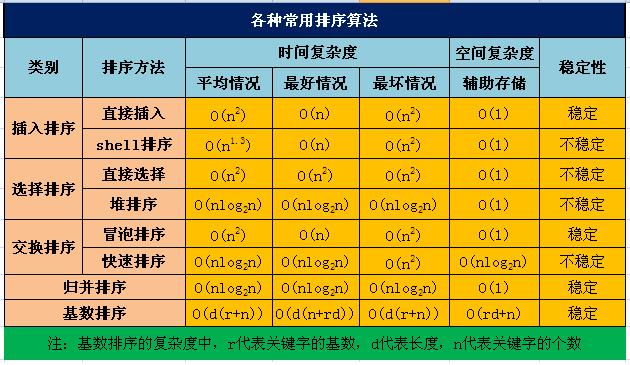
2.各种排序算法时间复杂度比较:
当n特别大时,则应该使用时间复杂度为O(NlogN)的排序方法:快速排序,堆排序,归并排序。
备注
推荐一本数据结构与算法的书:Data Structures & Algorithms in Java(Robert Lafore),中文版本叫做:Java数据结构和算法(第二版)
本文的部分排序示意图参照了:http://blog.csdn.net/hguisu/article/details/7776068










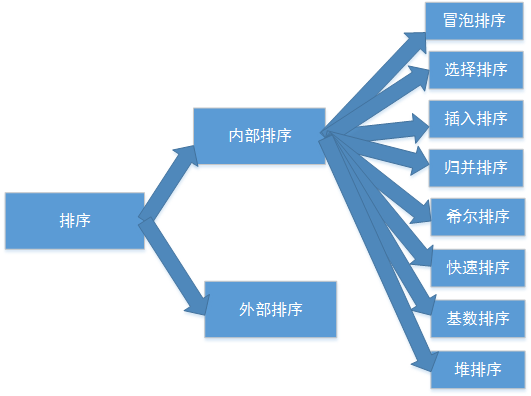














 7万+
7万+











 被折叠的 条评论
为什么被折叠?
被折叠的 条评论
为什么被折叠?








